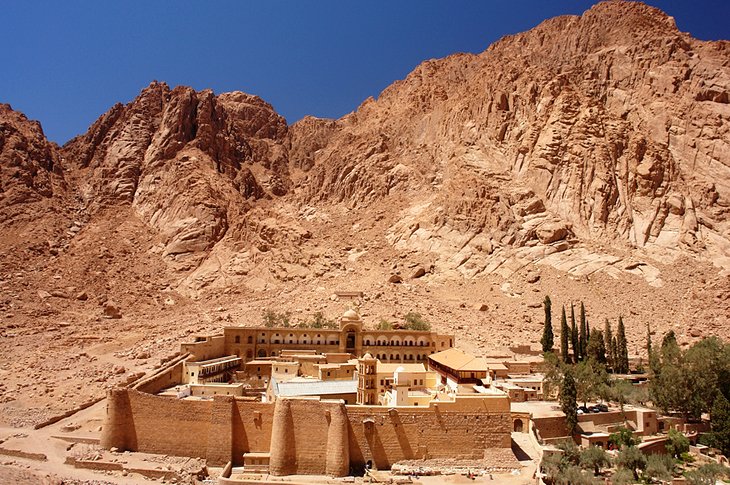If you plan on hiking the Sinai Trail, the spring and autumn seasons offer the most pleasant experience.
When planning your Egypt trips or Egypt and Jordan tours, make sure to include a visit to the awe-inspiring Sinai Peninsula. This remarkable region boasts numerous captivating attractions, but none can rival the significance of Mount Sinai and St. Catherine’s Monastery. These landmarks have played an integral role in history and continue to hold immense importance for the three major Abrahamic religions: Christianity, Islam, and Judaism.
Location
Both Mount Sinai and St. Catherine Monastery are situated in the Sinai Peninsula region of Egypt. The Sinai Peninsula lies between the Mediterranean Sea to the north and the Red Sea to the south. Despite being geographically located between Africa and Asia, it is considered part of North Africa. This peninsula spans an area of 60,000 square meters and is home to approximately 600,000 people.
Mount Sinai, also known as Jabal Musa (Mount Moses), is believed to be the same mountain mentioned in religious texts such as the Torah, Bible, and Quran. It is the sacred site where Moses received the Ten Commandments from God.
Located in a small valley to the north of Mount Sinai, St. Catherine’s Monastery is situated near the Egyptian town of Saint Catherine. The monastery is named after Catherine of Alexandria.
History
The Monastery, established by emperor Justinian I in 527, commenced construction around 530 CE. It is widely believed to have been built on the site of the burning bush mentioned in the Bible, Torah, and Quran, making it highly revered by Christianity, Islam, and Judaism. During the 7th century, the monastery served as a safe haven for persecuted Christian communities amidst the rise of Islam and later became a popular pilgrimage destination during the Middle Ages. St. Catherine’s Monastery remains the oldest continually inhabited Christian monastery globally and houses the world’s oldest operating library, renowned for its extensive collection of early Christian icons. Situated on Mount Sinai, this location holds significant importance in Jewish history as it is believed to be where God revealed Himself to Moses and presented the Ten Commandments. While some debate persists on the exact location, Mount Sinai is widely accepted as the site by Judaism, Christianity, and Islam.
Layout
The layout of Mount Sinai consists of a 2,285-meter (7,497 ft) moderately high mountain surrounded by even taller mountains. Adjacent to it is Mount Catherine, the highest peak in Egypt, standing at 2,629 meters (8,625 ft). At the foot of both mountains lies the Monastery of St. Catherine, situated at an elevation of approximately 1200 meters and covering an area of about 627 square meters.
Activities to enjoy at Mount Sinai
- Ascend Mount Sinai:
Do not miss the opportunity to witness the breathtaking view from the top of Mount Sinai. Follow in the footsteps of the holy prophet on this relatively easy climb, which can be done on foot or by riding locally available donkeys and camels. The panoramic view from the summit is truly unforgettable. - Explore the Camel Trail:
The Camel Trail serves as a pathway leading to Mount Sinai. Embark on this exciting hike, starting from the northern wall of St. Catherine’s Monastery. It takes approximately two hours to complete and offers uneven paths. Along the trail, you’ll find kiosks where you can rest, grab snacks, or even hire camels and donkeys for a more comfortable journey. - Experience the steps of Repentance:
Another trail that grants access to Mount Sinai is the Steps of Repentance. Although more challenging than the Camel Trail, the hike rewards you with stunning mountain views and an impressive sight of St. Catherine’s Monastery. The scenic beauty makes the trek well worth the effort.
Sights to see at St. Catherine’s Monastery
- The Burning Bush
One of the most sacred attractions at St. Catherine’s Monastery is the Burning Bush. Located in a chapel, it is kept in a chamber behind the altar of the basilica. Although usually off-limits to tourists, those fortunate enough to enter must do so barefoot, just as the Prophet Moses did when he first encountered it. The chapel’s altar features a silver star, believed to mark the spot where God spoke to Moses. The bush itself was transplanted from a nearby garden, now protected by a stone wall and tended by the monastery’s monks. - The Well of Moses
Within the monastery’s walls lies the Well of Moses, also known as the Well of Jethro. It is believed to be the very place where Moses met his wife, Zipporah. To this day, the well remains one of the primary sources of water for the monastery. - The Icons at The Basilica
St. Catherine’s Monastery boasts a remarkable collection of Christian icons, saved from the destruction ordered by Emperor Leo III in the 8th century. These icons, which date back to that period, exhibit a naturalistic style devoid of the later stylization. With around 2,000 icons in total, the basilica usually displays a select few for visitors to admire.
Best time to visit
For an ideal trip to the Sinai Peninsula, the recommended period is typically from April to October. If you plan on hiking the Sinai Trail, the spring and autumn seasons offer the most pleasant experience. Egyptian summers can be scorching, while winters bring freezing temperatures, occasionally even snowfall in the mountains.
St. Catherine’s Monastery welcomes visitors from 9 am to 12 pm, resulting in significant crowds during those hours. However, between 11 am and 12 pm, the number of tourists decreases, making it a slightly less crowded time to visit.

























































































































































































































